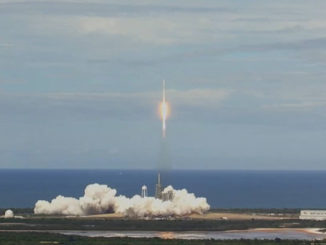Updated after launch.

India’s Polar Satellite Launch Vehicle delivered to orbit Wednesday the country’s third space mission dedicated to mapping natural resources, closing out a record year for Indian launch activity.
The Resourcesat 2A satellite rode the PSLV’s 38th flight into orbit from the Satish Dhawan Space Center on Sriharikota Island, India’s coastal spaceport on the shores of the Bay of Bengal about 50 miles (80 kilometers) north of the industrial city of Chennai.
The 36-hour countdown began Monday, and ground crews filled the PSLV’s second and fourth stages with their liquid propellants Tuesday. The rest of the rocket’s propulsion system consumed pre-packed solid fuel.
The 145-foot-tall (44-meter) PSLV XL rocket lit its first stage and four strap-on boosters at 0455 GMT Wednesday (11:55 p.m. EST Tuesday), and climbed through a heavy rain shower and low clouds from the so-called “First Launch Pad” at Sriharikota on 1.7 million pounds of thrust.
The launch occurred at 10:25 a.m. Wednesday India Standard Time.
Two more solid rocket boosters ignited around 25 seconds after liftoff at an altitude of around 9,000 feet (2,742 meters) to give the launcher an extra push.
The first four of the 39-foot-long (12-meter) auxiliary motors burned out and jettisoned around 70 seconds after blastoff, followed by the release of the last pair of boosters at T+plus 92 seconds.
The PSLV’s solid-fueled first stage consumed its solid propellants by T+plus 1 minutes, 50 seconds, giving way to the rocket’s hydrazine-burning second stage Vikas engine around 46 miles (74 kilometers) above Earth for a firing that lasted about two-and-a-half minutes with around 180,000 pounds of thrust.
The rocket’s on-board computer began closed-loop guidance during the second stage burn, and the PSLV’s 10.5-foot-diameter (3.2-meter) payload fairing fell away from the launcher at T+plus 2 minutes, 30 seconds.
The PSLV first headed east from the Indian space center, then turned south in a “dogleg” maneuver to avoid flying over Sri Lanka, accelerating to orbital velocity over the Indian Ocean.
Once the Vikas second stage engine emptied its 42-metric ton (90,000-pound) supply of hydrazine and nitrogen tetroxide propellants, the PSLV’s third stage — another solid rocket motor — ignited around T+plus 4 minutes, 23 seconds, for nearly two minutes, then coasted until separating from the rocket’s fourth stage at around T+plus 8 minutes, 41 seconds.
The twin-engine liquid-fueled fourth stage took control of the mission at T+plus 8 minutes, 51 seconds, for an eight-minute firing to reach the proper speed to enter the mission’s targeted polar orbit.
Separation of Resourcesat 2A, the mission’s only payload, came nearly 18 minutes after liftoff, prompting applause in the launch control center.

The Resourcesat 2A mission will track agriculture, water resources, soil contamination, and the growth of Indian cities. It is a follow-up to the Resourcesat 1 and Resourcesat 2 spacecraft launched by India in 2003 and 2011.
The PSLV delivered the 2,722-pound (1,235-kilogram) Resourcesat 2A satellite to an orbit around 511 miles (823 kilometers high) at an inclination of 98.7 degrees, according to flight data displayed inside the launch control center and on India’s live launch webcast. That is very close to the predicted orbital altitude of 514 miles (827 kilometers).
Officials declared the launch a complete success.
“Today, we have the successful launch of Resourcesat 2A, which is going to provide continuity to our three-tier imaging data, which will be extremely useful for various applications of land and water,” said A.S. Kiran Kumar, chairman of the Indian Space research Organization.
Designed for a five-year mission, Resourcesat 2A carries three cameras to take visible and near-infrared pictures, and India’s space agency said the new craft will extend the data pipeline previously fed by Resourcesat 2 launched in 2011.
P. Kunhi Krishnan, director of the Satish Dhawan Space Center, said after the launch that the success was “one more feather in the cap of PSLV, the most trustworthy launch vehicle of India.”
“We have accomplished now 37 consecutive successful missions by injecting very precisely India’s Resourcesat 2A into its orbit,” Kunhi Krishnan added.
The rocket launched Wednesday demonstrated several upgrades to the PSLV’s avionics systems, including an improved navigation system, a fiber-optic gyroscope, indigenously-produced computer processors, and an automated fueling system for the launcher’s fourth stage.
“For the first time, the propellant filling in the PS4 stage of PSLV was carried out in a totally remote fashion by modifying the ground servicing systems and also the PS4 stage,” Kunhi Krishnan said.
The streamline fueling procedure shaves one day off the PSLV’s launch preparations, and also makes for a safer work environment for the ground team preparing the rocket.
“The new avionics system flight tested on this mission will definitely provide useful input for the forthcoming missions, and also it will provide good data for finalizing the new-generation avionics architecture of our launch vehicles,” he said.
Wednesday’s launch capped a record year for India’s space program with the nation’s seventh rocket launch of 2016 that carried satellites into orbit. India logged six PSLV flights this year, and one launch of the more powerful Geosynchronous Satellite Launch Vehicle.
The achievement eclipses the five satellite launches India made in 2015.
India’s next launch is scheduled for around Jan. 20, when the first orbital mission by the GSLV Mk.3 rocket will take off on a test flight to prove out the country’s largest-ever launch vehicle.
Email the author.
Follow Stephen Clark on Twitter: @StephenClark1.



